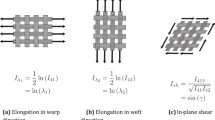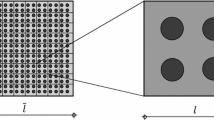Abstract
An efficient simulation of thermal and mechanical models involved in thermosetting composites forming needs to overcome some numerical difficulties related to: (i) the multi-scale behaviour; (ii) the complex geometries involved needing too many degrees of freedom; (iii) the large time intervals where the solution has to be computed; (iv) the non-linearity of the involved evolution equations; (v) the numerous couplings… In this work, an efficient strategy based on a separated representation is proposed. This method enables to avoid the use of an incremental strategy and can lead to impressive computing time savings especially when the model involves fine meshes and very small time steps. The local non-linear chemical kinetics and its coupling with the global heat balance equation are naturally introduced in the separated representation algorithm. Moreover, the dependence of the thermal conductivity and the specific heat on the temperature and on the reaction advancement degree are also taken into account. Knowing the history of the temperature field, the separated representation is again used to solve the thermo-mechanical problem in order to determine the residual stresses.










Similar content being viewed by others
References
Rabearison N, Jochum Ch, Grandidier JC (2009) A FEM coupling model for properties prediction during the curing of an epoxy matrix. Comp Mat Sci 45:715–724
Li M, Zhu Q, Geubelle PH, Tucker CL III (2001) Optimal curing for thermoset matrix composites: Thermochemical considerations. Polym Compos 22:118–131
Zhu Q, Geubelle PH, Li M, Tucker CL III (2001) Dimensional accuracy of thermoset composites: simulation of process-induced residual stresses. J Compos Mater 35:2171–2205
Cheung A, Yu Y, Pochiraju K (2004) Three-dimensional finite element simulation of curing of polymer composites. Finite Elem Anal Des 40:895–912
Ladevèze P (1999) Nonlinear computational structural mechanics—new approaches and non-incremental methods of calculation. Springer Verlag
Ladevèze P, Loiseau O, Dureisseix D (2001) A micro-macro and parallel computational strategy for highly heterogeneous structures. Int J Numer Meth Eng 52:121–138
Ammar A, Mokdad B, Chinesta F, Keunings R (2006) New family of solvers for some classes of multidimensional partial differential equations encountered in kinetic theory modeling of complex fluids. J Non-Newtonian Fluid Mech 139:153–176
Ammar A, Mokdad B, Chinesta F, Keunings R (2007) A new family of solvers for some classes of multidimensional partial differential equations encountered in kinetic theory modeling of complex fluids. Part II: Transient simulation using space-time separated representation. J Non-Newtonian Fluid Mech 144:98–121
Chinesta F, Ammar A, Lemarchand F, Beauchene P, Boust F (2008) Alleviating mesh constraints: model reduction, parallel time integration and high resolution homogenization. Comput Meth Appl Mech Eng 197:400–413
Ammar A, Chinesta F, Joyot P (2008) The nanometric and micrometric scales of the structure and mechanics of materials revisited: an Introduction to the challenges of fully deterministic numerical descriptions published in An introduction to the challenges of fully deterministic numerical descriptions 6:191–213
Abou-Msallem Y, Boyard N, Jaquemin F, Poitou A, Delaunay D, Chatel S (2008) Identification of thermal and rheological properties of an aeronautic epoxy resin-simulation of residual stresses. Int J Mater Form (Supp. 1):579–582
Abou-Msallem Y (2008) Thermal and mechanical characterisation of an aeronautic composite material during the manufacturing process-contribution to the estimation of the residual stresses, PhD Thesis. Ecole Centrale Nantes, France
Kamal MR, Sourour S (1973) Kinetics and thermal characterization of thermosets cure. Polym Eng Sci 13:59–64
Bailleul JL, Delaunay D, Jarny Y (1996) Determination of temperature variable properties of composite materials: methodology and experimental results. J Reinf Plast Comp 15:480–496
Ammar A, Normandin M, Daim F, Gonzalez D, Cueto E, Chinesta F (2009) Non incremental strategies based on separated representations: Application in computational rheology. Commun Math Sci accepted for publication
Author information
Authors and Affiliations
Corresponding author
Rights and permissions
About this article
Cite this article
Prulière, E., Férec, J., Chinesta, F. et al. An efficient reduced simulation of residual stresses in composite forming processes. Int J Mater Form 3 (Suppl 2), 1339–1350 (2010). https://doi.org/10.1007/s12289-009-0675-6
Received:
Accepted:
Published:
Issue Date:
DOI: https://doi.org/10.1007/s12289-009-0675-6




